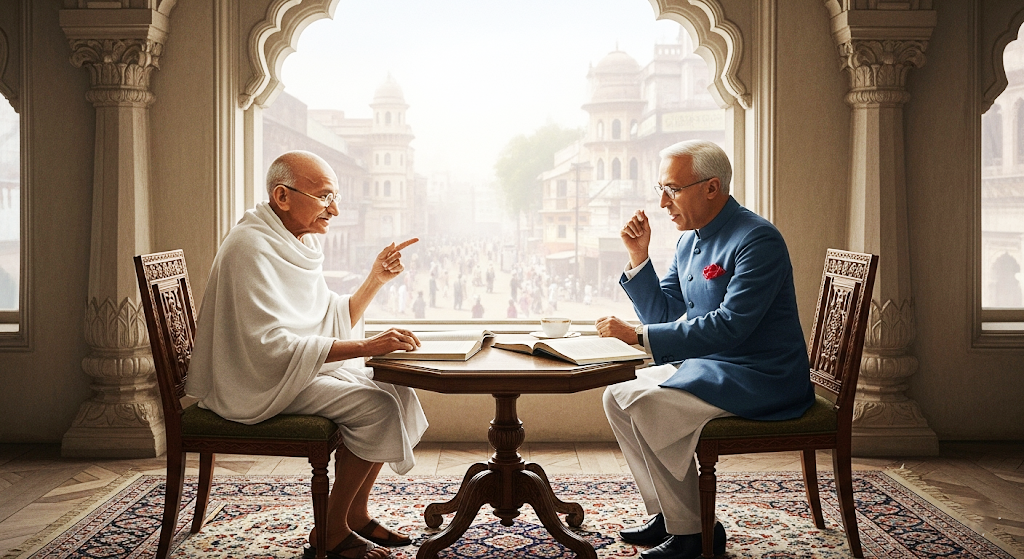 Lucknow: Lucknow, 2025. The City of Nawabs turned a page in history this year, marking 250 years as a capital city—a quarter of a millennium of politics, governance, rebellion, and resilience. From the elegant courts of the Nawabs to the echoing corridors of the Vidhan Sabha, Lucknow’s transformation has been dramatic, turbulent, and deeply symbolic of India’s wider political story. What began in 1775 as Nawab Asaf-ud-Daula’s decision to shift the Awadh capital from Faizabad to Lucknow has since unfolded into a saga of power, culture, and governance—one that continues to shape Uttar Pradesh and, by extension, India.
Lucknow: Lucknow, 2025. The City of Nawabs turned a page in history this year, marking 250 years as a capital city—a quarter of a millennium of politics, governance, rebellion, and resilience. From the elegant courts of the Nawabs to the echoing corridors of the Vidhan Sabha, Lucknow’s transformation has been dramatic, turbulent, and deeply symbolic of India’s wider political story. What began in 1775 as Nawab Asaf-ud-Daula’s decision to shift the Awadh capital from Faizabad to Lucknow has since unfolded into a saga of power, culture, and governance—one that continues to shape Uttar Pradesh and, by extension, India.
The Nawabi Era (1775–1856): Politics in the Court of Elegance
When Nawab Asaf-ud-Daula moved his seat of power to Lucknow, he was not just escaping family disputes in Faizabad—he was laying the foundations of a new political capital. His court became a beacon of Awadhi culture, its elegance visible in monuments like the Bara Imambara and the Rumi Darwaza, but its authority rooted in governance.
The Nawabs presided over Awadh as semi-autonomous rulers under a weakening Mughal Empire. Their administration revolved around the Nawab’s court, with the diwan managing revenue and taluqdars controlling estates and order in the countryside. This structure was efficient but fragile—heavily reliant on loyalty, patronage, and the balancing act of Persian, Mughal, and local Awadhi traditions.
Under Asaf-ud-Daula, famine relief became a political tool; public works doubled as social welfare and architectural marvels. Yet the Nawabs’ grandeur had a price. Their reliance on British loans, extravagant lifestyles, and internal dissent sowed the seeds of vulnerability. By the mid-19th century, Nawab Wajid Ali Shah’s court was dazzling but financially weakened—an opportunity the East India Company would seize.
1857 and the Siege of Lucknow: Rebellion Against Misrule
The annexation of Awadh in 1856, justified by the British as punishment for misgovernance, changed Lucknow’s trajectory forever. Wajid Ali Shah was exiled to Calcutta, and the city’s pride turned into outrage.
Just a year later, Lucknow became one of the fiercest battlegrounds of the First War of Independence (1857). The Siege of the Residency became legend: for 87 days, sepoys and local leaders surrounded the British garrison, turning Lucknow into a crucible of rebellion. When British forces recaptured the city in 1858, Lucknow was scarred—politically punished, socially transformed, and administratively reorganized.
The British dismantled Nawabi institutions, replacing them with colonial structures. The commissioner system centralized authority, taluqdars were co-opted back into power under new land settlements, and Lucknow was subdued. Its reputation as a rebellious city lingered, but its governance was now firmly under British bureaucracy.
Colonial Rule and the Stirring of Nationalism (1858–1947)
Even as the British tightened control, Lucknow remained restless. The city became part of the United Provinces of Agra and Oudh, and in 1920, the provincial capital shifted back from Allahabad to Lucknow. The construction of the Council House (Vidhan Sabha) in 1928 signaled Lucknow’s reinstated importance in governance.
But politics in Lucknow was no longer confined to administration—it was spilling into the streets.
In 1916, the Lucknow Pact between the Congress and the Muslim League showcased an extraordinary moment of Hindu-Muslim unity, with Tilak and Jinnah at the forefront. The pact, which demanded self-governance and separate electorates for Muslims, influenced the Government of India Act 1919. Ironically, while it strengthened the nationalist cause, it also planted seeds of communal division.
The city became a stage for movements: the Khilafat Movement, Gandhi’s call for non-cooperation, and the Kakori Conspiracy of 1925, when revolutionaries like Ram Prasad Bismil struck a blow against British railways near Lucknow.
By the 1940s, Lucknow was both a hotbed of constitutional negotiation and revolutionary zeal. It embodied the paradox of colonial governance: a city tightly controlled, yet impossible to silence.
Post-Independence: The New Capital of Uttar Pradesh (1947–Present)
With independence in 1947, the United Provinces became Uttar Pradesh, and Lucknow was crowned its permanent capital. The Vidhan Sabha, Secretariat, and Raj Bhavan became symbols of democratic governance, as Lucknow transitioned from colonial commissioner rule to elected leadership.
Lucknow soon became the nerve center of India’s most politically influential state. Uttar Pradesh, with its vast population, has produced prime ministers, cabinet leaders, and national movements—and Lucknow has often been the launchpad.

The city’s political life has reflected the churn of India’s democracy. The Congress era saw leaders like Jawaharlal Nehru and Govind Ballabh Pant influence policy from Lucknow. But by the late 20th century, the capital became the arena for regional powerhouses: the Samajwadi Party (SP), the Bahujan Samaj Party (BSP), and later, the Bharatiya Janata Party (BJP).
In the 1990s, Dalit politics under Mayawati reshaped the cityscape. Memorials to Dr. B.R. Ambedkar and other icons altered Lucknow’s skyline, making governance as much about symbolic space as policy. The Vidhan Sabha became a stage where caste equations, coalition politics, and electoral strategies played out.
Lucknow mirrored Uttar Pradesh’s diversity: Hindus, Muslims, Dalits, and upper castes, each with political aspirations, making the city a microcosm of India’s democracy.
Governance in a Modern Metropolis
As politics roared in its chambers, governance faced new challenges. Urbanization transformed Lucknow into one of India’s fastest-growing cities. Managing infrastructure, housing, transport, and environment became the priority of the Lucknow Municipal Corporation and the state government.
A milestone came with the Lucknow Metro, approved in 2013 under Akhilesh Yadav and inaugurated in 2017 under Yogi Adityanath and Rajnath Singh. Linking Munshipulia to CCS Airport, the metro became both a symbol of modern governance and a test case for public infrastructure in Uttar Pradesh.
Beyond transport, Lucknow is being positioned as India’s first AI city and a future IT hub. Defense corridors and DRDO centers manufacturing BrahMos missiles are now part of the city’s economic blueprint. The Gomti Riverfront, tech parks, and smart city projects attempt to balance heritage with development.
Yet challenges abound. Education gaps persist, with tens of thousands of teaching posts vacant. Environmental concerns—from vanishing wetlands to pollution—threaten sustainability. The city’s governance must constantly mediate between growth and preservation, political ambition and civic responsibility.
The Legacy of Social Capital
If there is one thread running through 250 years of Lucknow as a capital, it is its Ganga-Jamuni Tehzeeb—the composite culture of coexistence between Hindus and Muslims, poets and politicians, rulers and rebels. This ethos has often acted as a form of social capital, enabling communities to navigate governance challenges through dialogue rather than confrontation.
The Lucknow Pact of 1916 embodied this spirit; the post-independence coexistence of Nawabi heritage and Ambedkarite memorials reaffirms it. Yet this legacy has also been fragile, tested by communal tensions and political polarization.
Governance in Lucknow today depends on reviving this social capital, ensuring inclusivity in policies, and embracing both tradition and innovation.
A City That Governs the Heart of India
From Asaf-ud-Daula’s move in 1775 to today’s vision of a global metropolis, Lucknow’s journey as a capital tells the story of power’s shifting faces: Nawabi elegance, colonial bureaucracy, nationalist fervor, and democratic contest.
It has been a city of rebellion and reconciliation, of syncretic culture and sharp politics. The Bara Imambara and the Vidhan Sabha stand at two ends of this journey—one echoing the grandeur of feudal courts, the other the debates of a democracy.
As Lucknow celebrates 250 years as a capital in 2025, it does so not just as Uttar Pradesh’s administrative hub but as a city that embodies India’s political spirit—resilient, adaptive, and endlessly evolving. Its next chapter will depend on how it balances its storied past with the demands of the future, ensuring that the heart of Awadh continues to beat strongly as the heart of Uttar Pradesh.






